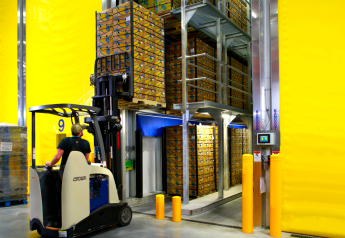AFT praises bill addressing the integration of solar energy and agriculture

The American Farmland Trust has praised the introduction of the bipartisan Agrivoltaics Research and Demonstration Act of 2023.
Introduced by Sens. Martin Heinrich (D-N.M.) and Mike Braun (R-Ind.), the legislation would establish a framework for the USDA to define and evaluate agrivoltaics to better incorporate the practice of pairing solar energy generation with agricultural production into USDA programs, according to a news release. It would also authorize the USDA to create a network of research and demonstration sites, the release said.
The bill’s introduction comes about a week after the group released its recommendations to Congress to advance a smart solar buildout in the upcoming farm bill that benefits rural communities and protects farmland and farm viability.
“We applaud Senator Heinrich and Senator Braun for their forward-thinking leadership in introducing this bill,” Tim Fink, policy director for American Farmland Trust, said in the release. “As the essential transition toward renewable energy accelerates across the country, it must be done in a way that strengthens rural communities and minimizes the footprint on our most productive farmland. This legislation would help advance the potential for agrivoltaics to do both.”
According to the Department of Energy, achieving the goal of a decarbonized electric sector by 2050 will require converting 10.4 million acres of land to solar energy generation. Farmland is often favored by solar developers, particularly high-quality farmland, because it is flat, sunny, cleared and near energy infrastructure. In fact, recent AFT modeling revealed that 83% of new solar energy development is likely to take place on farmland if additional policy steps are not taken, with half of that on the nation’s best land for producing food and crops, the release said.
Alongside state and local governments, the federal government — and especially USDA — has an important role to play in minimizing this conversion of farmland and ensuring the solar buildout strengthens rural communities, according to the release.
To accomplish this, AFT has developed four “smart solar principles” for policymakers, developers and communities to follow, the release said:
- Prioritize siting on the built environment and marginal land.
- Safeguard the ability for land to be used for agriculture.
- Grow agrivoltaics for agricultural production and solar energy.
- Promote equity and farm viability.
Agrivoltaics refers to the practices of integrating solar energy generation and farming on the same piece of land, which could potentially reduce displacement of agricultural production from farmland because of solar development, the release said.
The concept has been gaining attention in land-constrained countries like Japan and Germany as well as in states like Massachusetts and New Jersey.
“If included in the Farm Bill, the Agrivoltaics Research and Demonstration Act would secure USDA’s role in advancing this innovation alongside the Department of Energy, AFT, and other partners across the country,” Fink said in the release. “Together, we are seeking ways to reduce displacement of farming from productive land as a result of solar energy development.”
AFT’s farm bill smart solar platform urges Congress to direct and empower USDA agencies — including the Natural Resources Conservation Service, Rural Development, and research agencies — to provide the guidance, support and leadership that will enable state and local decision-makers to put AFT’s full suite of smart solar principles into action.
In addition to recommending the actions in this bill, the platform urges Congress to direct USDA to develop guidance to ensure that land converted to solar can be returned to agricultural use, that the Rural Energy for America Program serve as a model for smart solar deployment, and that additional research be conducted to advance smart solar, the release said.







